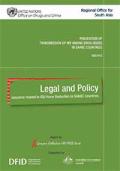Publications - Released in 2007
AIDS is an extraordinary disease. As such, it requires an extraordinary response.
In South Asia, the HIV epidemic is heterogeneous in nature. Bangladesh, Nepal and Pakistan have HIV
epidemics that are primarily driven by injecting drug use. India — a country with one of the largest numbers of people living with HIV/AIDS — features an epidemic in its North Eastern region which is primarily driven by injecting drug use. Bhutan, the Maldives and Sri Lanka are countries with growing number of injecting drug users. This document examines whether the laws and policies currently in South Asia are adequate to meet the challenges posed by the threat of HIV/AIDS.
A consistent body of evidence has established that comprehensive HIV prevention programmes which
include needle syringe programmes and oral substitution as part of a comprehensive package reduce drug-related HIV risk behavior (such as needle sharing, unsafe injecting, and frequency of injection). Similarly, there is strong evidence that substitution treatment reduces criminal behavior and illicit opioid use. It also increases treatment retention and improves the overall health status of drug users infected with HIV. These are outcomes which we all seek to promote.
Downloads
Organizations
- United Nations Office on Drugs and Crime (UNODC)
- Department for International Development (DFID)
- Australian Aid (AusAID)






